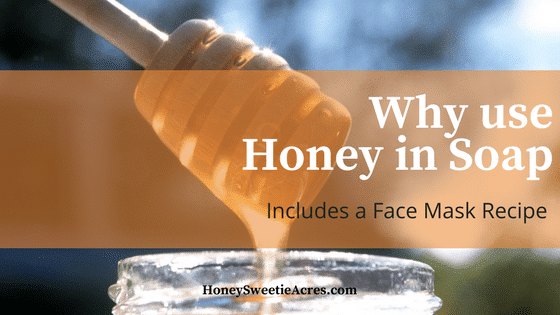Why Use Honey in Soap?
Most people are surprised to hear that we spent a year researching soap BEFORE we opened our doors as a business. As part of this process we learned that the skin benefits of honey are incredible. So, we have added bee-hives to the farm so that we will have our own local supply. Until we established our own hives, we gave little thought to how much work actually goes into a single teaspoonful of honey or how wondrous a creature the honey bee actually is.
Why go to this much trouble? Research by Food Safety News in 2011 discovered that most of the honey sold in grocery, drug and big box stores isn’t real honey, as the pollen has been removed. To learn more about what constitutes REAL honey, click on this link: http://www.foodsafetynews.com/2011/11/tests-show-most-store-honey-isnt-honey/
How Honey is Really Made
Bees make honey so that they will have food stores during the winter. Older worker bees gather the nectar and and store it in their “honey stomach”. In this stomach, enzymes break down the complex sugars into simple sugars, so that they will not crystallize. This process is called inversion. (Nectar contains 80% water and would ferment and spoil if left in its natural state.)
With his belly full, the bee returns to the hive, then regurgitates the modified nectar for another bee. The hive bee ingests the modified nectar and further breaks down the sugars, regurgitating into a honeycomb cell.
Next, the hive bees gather round the cells to fan the nectar with their wings and force evaporation of its remaining water content. As the water evaporates, the sugars thicken into honey. Once finished, the bees cap off and seal the honey into the honeycomb for later consumption.
Why use Honey in Soap? The skin loving benefits of honey may surprise you:
- Healing: Honey contains small amounts of hydrogen peroxide, which works as a form of natural Neosporin. Honey dressings help to heal scrapes, cuts and burns.
- Antioxidant: Honey contains the antioxidant polyphenols, which helps shield your skin cells from free radical damage.
- Antimicrobial: Honey has antimicrobial qualities that allow cleansing of the skin without stripping the skin’s natural oils. Research has show that the antimicrobial properties can assist with clearing up acne as well.
- Damaged Skin: Honey does possess carcinogen preventing and anti-tumor properties.
- Beneficial Enzymes: Honey contains beneficial enzymes, amino acids, pigments, pollen and traces of nutrients from both the bees and the plants they consume.
- Hygroscopic: Honey retains and draws moisture into the skin
(Health Benefits of Honey, tips to prevent hypertension, diabetes, cancer and heart attacks. By Amanda Wilson).
How do we use Honey in Soap?
When using honey in soap, we add approximately 2 tablespoons per pound of soap depending on the recipe. If TOO much honey is used, the soap will not harden properly. The soap will weep and ooze the excess, be sticky and wash away quickly. If too little honey is used, the benefits will be minuscule. However, if you get it “just right”, the soap will lather beautifully, smell clean with a hint of caramel sweetness. Goat milk and honey soap has many benefits: it will exfoliate the dead skin cells, draw moisture to the skin, plus nourish and protect. If honey is what you are looking for, each and every one of our bars of soap contain it ̶ for sensitive skin try our natural unscented goat milk bar soaps.
Make your own “Honey Skin Mask”!
Mix these 3 ingredients in a bowl, apply to your face with a brush or your fingers. Let dry for 20 minutes, then rinse away thoroughly.
- 1 heaping tablespoon of plain, thick yogurt.
- 2 teaspoons of REAL honey (see link above)
- 1 or 2 drops of an essential oil (lavender or chamomile)
ENJOY!!!!


